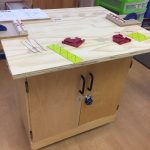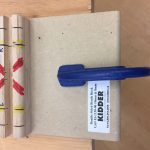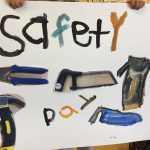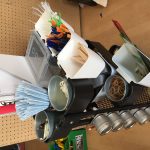Our goal is to create a Professional Learning Community (PLC) based on researching and implementing STEM activities into project-based learning in full-day kindergarten to make learning more engaging, authentic and self-motivating for students and educators, and to share this learning with others. We believe that project-based learning is an effective way to differentiate curriculum and integrate programming in a cross-curricular manner. Meeting regularly with other kindergarten teachers would allow us to research and collaborate engaging ways to provide students with hands-on experiences in developing solutions to real-world problems using the engineering design process (STEM). As part of our project, Makerspaces would be set up within our classrooms where students could plan and develop solutions to the project/task/problem. Release time would be used to co-teach and observe in each other’s classrooms.
Team Members
Robertson Anderson
Durham District School Board
Crystal Jeffs
Durham District School Board
Stephanie Keith
Durham District School Board
Michelle Price
Durham District School Board
Professional Learning Goals
- Created a PLC with two full-day kindergarten teams to meet regularly to share/discuss scholarly journals and research and to collaboratively plan STEM activities (connected to our commitment to Professional Knowledge, Professional Practice and Ongoing Professional Learning as we strive to be current in Professional Knowledge, and improve our practice through ongoing inquiry and dialogue)
- Increased student/educator engagement and motivation through the use of STEM (Commitment to Students and Student Learning)
- Used STEM activities within project-based learning to teach expectations in a cross-curricular manner (Commitment to Students and Student Learning and Professional Practice)
- Shared our learning with others within our school community (Leadership in Learning Communities)
Activities and Resources
Activities:
- As we began our project, our school administration made STEM a focus in our BCI meetings with an emphasis on the “M” in STEM as we explored ways to notice and name the math learning in STEM (e.g., we meet every six weeks to learn theory and collaborate with our primary division)
- Interviewed kindergarten teachers/Designated Early Childhood Educators (DECEs)
- Co-planned and co-taught lessons on the design process: thinking, planning, building, playing/testing, improving and finally sharing (co-constructing labels/pictures of design process to post in the room with students in terms that they could understand)
- Using STEM kits based on fairy tales (*noted in resources)
- We invited team members to take part in the Global Cardboard Challenge, in connection with the Imagination Foundation, where students are challenged to create and build using cardboard, recycled materials and imagination (based on the short film Caine’s Arcade)
- We held Lunch and Learn sessions for our kindergarten division to collaborate, research and plan the implementation of STEM activities (for instance, one was based on how to build schema using technology, books and sharing connections and experiences)
- Collaborated on creating mobile makerspaces for every kindergarten classroom
Lunch & Learn: Activities and Resources to use in connection with mobile makerspaces (see additional comments in Challenges section)
- Created kindergarten workbenches
- Created student-led safety videos with kindergarten and Grade 1 students to share with kindergarten division and safety posters
- Shared student safety videos at a staff meeting
- Summative teacher interview to document learning
- Sharing with our Grade 1 partners
- Sharing at staff meeting
Resources:
We bought books and resources for teachers to implement STEM challenges (e.g., fiction and non-fiction books to help build schema about bridges to support bridge building challenges). Hand tools and materials were purchased from Kidder so students could build in our makerspaces (e.g., mitre boxes, handsaws, balsam wood, etc.). Mobile makerspaces were set up within our classrooms to store resources (e.g., fasteners like tape, straws, etc.) and planning templates for students in a cart that could be moved to any location in the classroom.
Unexpected Challenges
Our biggest challenge for our Lunch and Learns was the timetable. We have staggered lunch so we were unable to have all Early Childhood Educators (ECEs) join us for a lunch and learn at the same time since half of them were on lunch duty at the time.
During discussions, teachers and administrators shared their feelings about the STEM approach. When asked about the challenges of STEM, many stated that finding resources could be a challenge. Some kindergarten educators raised additional concerns (i.e., that STEM seemed to be an add-on or might not be suitable for the kindergarten learner). We addressed these challenges at our Lunch and Learns by providing teachers with resources (e.g., journal articles and blogs) to learn more about STEM in kindergarten.
Teachers expressed concern over the mobile makerspace carts turning into an art activity centre. We addressed this concern by having a Lunch and Learn that focused on the article “7 Tips for Planning a Makerspace” by Leila Meyer and “Six Characteristics of a GREAT STEM” lesson by Anne Jolly. Both articles had great information about creating a makerspace and implementing STEM lessons. Through discussion with the teachers at the Lunch and Learn, we decided to have students make a plan either on paper or verbally before they were able to use the materials on the makerspace cart to encourage their use of the design process. We provided a variety of planning templates for the makerspace, as well as a variety of challenges.
Another challenge raised by the teachers was the kindergarten learner. Some teachers felt that the students were too young to complete these tasks. We provided resources/article such as “STEM Education in the Elementary Classroom” by Janelle Cox, which addressed the question, Why start STEM so young? She stated that an easy way to integrate STEM into any subject matter is to have students read a storybook and design a solution to a problem one of the characters faced. This quote has sparked some teachers to reflect on how to integrate STEM in a quick and easy way. Some teachers expressed that it overwhelms them to add another component to their daily lessons. We discussed how we can create rich tasks that are curriculum-based and not an add-on (for instance, before taking part in a school wide cleanup, a teacher suggested we create a STEM project to make a tool that can pick up garbage so you don’t have to use your hands).
Teachers in our division were interested in developing a makerspace that incorporated tools designed for children. Our team purchased tools for the kindergartens to use with teacher support. There were some concerns from educators. Most concerns centred on two things:
- How to ensure the safety of students in the classroom environment.
- Teachers’ own comfort level with using tools and teaching young children how to use these tools.
We took the following steps to address their concerns:
- We repurposed wooden play sinks into child-friendly workbenches that would be the right height for students to use and would enable the use of clamps and mitre boxes. We added visual reminders to aid students (e.g., a red X added to the mitre box to remind students where their hands could safely be placed or an arrow and a happy face to remind students were to put their gusset on the jointer).
- Our team worked with the kindergarten students in their classes to create safety videos. A senior kindergarten student interviewed either another senior kindergarten student or a Grade 1 “expert” about how to use a tool safely (e.g., a handsaw purchased from Kidder). The expert described the parts of the tool and demonstrated how to use the tool properly. The videos were then shown to the kindergarten students in our division. Other students used mixed media to create safety posters to add to the videos (i.e., Be safe. Put googles on. Tie your hair back. Push your sleeves up.).
- We held a Lunch and Learn where teachers had hands-on instruction and an opportunity to use tools before they incorporated them in their classrooms. This increased their knowledge and comfort level. We also provided the teachers with a project and materials to use in the classroom with the tools (e.g., making frames). Providing activities, materials and training increases teacher comfort, decreases teachers’ planning time and increases the likelihood that teachers will carry out STEM/makerspace projects in their classrooms.
- Lunch and Learns to share how tools were integrated in STEM challenges (e.g., individual students used handsaws to cut balsam wood to make drumsticks or the neck of the guitar in connection with the STEM music kit provided by the DDSB, another class is in the process of using tools to create cars, etc.). Project-based learning (e.g., students used the makerspace to create incubators and other medical tools when taking part in an inquiry about hospitals in connection with our dramatic play centre).
Enhancing Student Learning and Development
We demonstrate our commitment to Professional Knowledge, Professional Practice and Ongoing Professional Learning as we strive to be current in Professional Knowledge and improve our practice through ongoing inquiry and dialogue.
We shared best practises on a regular basis with an emphasis on capturing learning within the class. We co-planned a lesson during our BCI using the book The Three Bears where students were challenged to build a chair that could fit all three bears on it (emphasis on using the design process).
We went through the STEM process and began with thinking about what a chair is. Students defined a chair as something we sit on. It has four legs and a back. We then began to design our chair. We looked at pictures of chairs and the students chose what material they would like to make their chair out of. Students drew a plan of their chair and then they were ready to build. Students were directed to the groups they were in based on the material that they chose. They began building their chair with the group, but they had a choice to build it individually if they wanted to.
As part of our BCI, teachers observed the lessons. We decided to break up the lesson and observe different teachers throughout different parts of the STEM process. Throughout the lesson, the teachers who were observing, prompted students and asked questions about what they were doing. Every child could talk about their project and share their thinking.
A primary goal for the project is to share our learning with the kindergarten team and the rest of the school community. We have an ongoing dialogue with our kindergarten team through daily interactions, our Lunch and Learns, staff meetings and observing/co-teaching sessions. We share our learning with the school community through discussions during BCIs and presentations during staff meetings. Our school hosted a STEM night on April 20 where members of the team planned STEM challenges for kindergarten and primary classes to participate in.
Sharing
- We have provided teachers with a STEM activity binder that we continue to add to
- We have a folder on the T-drive that teachers can access and add to at any time
- We continue to add templates or resources to our mobile makerspace carts
- We continue to add tools to our makerspaces as needed
Project Evaluation
Professional Learning Goals – How did you determine that your learning goals have been met?
1. We created a PLC with full-day kindergarten teams to meet regularly to share/discuss scholarly journals and research and to collaboratively plan STEM activities (connected to our commitment to Professional Knowledge, Professional Practice and Ongoing Professional Learning as we strive to be current in Professional Knowledge and improve our practice through ongoing inquiry and dialogue)
- Articles and discussions at Lunch and Learn
- BCI co-planning, assessment, co-teaching practise
- STEM binders
- STEM activities on T-drive for the whole school
2. Increase student/educator engagement and motivation through the use of STEM (Commitment to Students and Student Learning)
- Hands-on activities that students are thoroughly engaged in
- Implementation of mobile makerspace carts to increase students implementing the design process
- Provide teachers with activities for the makerspace cart
- Provide teachers with STEM activities and materials to make the STEM approach easier and more accessible
- We have proof of increase in teacher engagement as they answered the questionnaire at the end of the project and through our ongoing discussions, as well as comfort level and the implementation of STEM activities have increased
- All classes document the learning in STEM activities using a STEM bulletin board with all the process headings think, plan, build and test, improve, share. Pictures, student work and projects are on these boards or under them.
3. Use STEM activities within project-based learning to teach expectations in a cross-curricular manner (Commitment to Students and Student Learning and Professional Practice)
- All classes are using STEM activities in their class
- Cross-curricular approach with a focus on the design process, math, problem-solving and language
- STEM activities cover a wide variety of expectations within the four frames
4. Share our learning with others within our school community (Leadership in Learning Communities)
- Sharing at staff meeting
- Create workshop PowerPoint presentation for summer institute or for next year
- We would have created a workshop for other kindergarten teams to collaborate on a larger scale
- Additional Lunch and Learns with the primary division
- Move from STEM towards STEAM as we look for meaningful ways to integrate the arts
- T-drive with journal articles, activities, assessment, documentation and resources
We provided teachers with a questionnaire prior to the project and at the end of the project. Each teacher increased their understanding about STEM and makerspaces. Each teacher documents the STEM process and activities using STEM boards. Each teacher uses makerspaces as part of the STEM approach. Each teacher has increased their comfort level with STEM.
Our project was a huge success. We met our professional learning goals and we continue to learn and grow. Teachers in our kindergarten division have learned how to incorporate STEM activities in their classrooms and are documenting the learning using STEM boards. Students are actively engaged in hands-on learning and understand the process involved in STEM activities, from the thinking and planning phase (where teachers are developing students’ schema and processing skills), to the building and testing phase (where teachers are developing students’ problem-solving skills, collaboration and communication skills) to the testing phase (where students/teachers are developing resiliency skills, problem-solving skills and creative thinking skills) and the sharing phase (where students develop their oral communication and vocabulary). We have provided the teachers in our school with professional learning about STEM and have provided them with materials to implement them as we strive to effectively teach 21st-century kindergarten learners. We are helping to foster a culture of STEM within our school community.
What would we have done differently?
- We would have created a workshop for other kindergarten teams to collaborate on a larger scale
- Additional Lunch and Learns with the primary division
- Move from STEM towards STEAM as we look for meaningful ways to integrate the arts
- We purchased STEM Challenge: Building Famous Landmarks from Teachers Pay Teachers to add photos of structures found around the world to our carts, but we would like to further explore more culturally responsive practices when developing STEM challenges
Resources Used
Resources Created:
- Safety videos to train students and teachers to use tools
- STEM activity sheets from STEM night and Lunch and Learn sessions
- STEM teacher interview sheet and STEM binders
Resources:
Barr, Janis and Rita Vandel Heuvel. (2017). Canadian Daily STEM Activities. Chalkboard Publishing Inc.
Barr, Janis and Rita Vandel Heuvel. (2016). Canadian Daily STEM Activities. Chalkboard Publishing Inc.
Gerstein, Jackie. (2015). STEM for Elementary School Students – How to Instill a Lifelong Love of Science. Blogs, STEM News & Views.
Johmann, Carol A. and Elizabeth J. Rieth. (1999). Bridges! Amazing Structures to Design, Build and Test. Library of Congress Cataloging in Publication Data.
Jolly, Anne. (2017). Six Characteristics of a Great STEM Lesson. Blog STEM by Design.
Meyer, Leila. (2017). 7 Tips for Planning a Makerspace. The Journal.
Prince, April Jones. (2005). 21 Elephants and Still Standing. Houghton Mifflin Company.
Stith, Jennifer B. (2015). Applying the Standards: STEM Kindergarten. Carson-Dellosa Publishing, LL.
Three Little Pigs Problem-Solving STEM Kit from LakeshoreLearning.com
Three Billy Goats Gruff STEM Kit
Goldilocks & The Three Bears Problem-Solving STEM kit
Resources Created
These resources will open in your browser in a new tab, or be downloaded to your computer.





